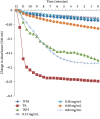Phytochemical, Antioxidant and Mitochondrial Permeability Transition Studies on Fruit-Skin Ethanol Extract of Annona muricata
- PMID: 32089679
- PMCID: PMC7024090
- DOI: 10.1155/2019/7607031
Phytochemical, Antioxidant and Mitochondrial Permeability Transition Studies on Fruit-Skin Ethanol Extract of Annona muricata
Abstract
Uncontrolled cell proliferation hallmarks cancer and most cancer cells have developed multiple resistance to the drugs employed for their treatment. The study examined the phytochemical and antioxidant properties of the fruit-skin ethanol extract of Annona muricata Linn. (ESA) and its effect on rat liver mitochondrial membrane permeability transition (MMPT). Qualitative phytochemical study and antioxidant assays were carried out following established protocols while the opening of the MMPT pore in the presence of varying concentrations of the extract was assayed spectrophotometrically under succinate-energized conditions. Calcium chloride (CaCl2) and spermine were used to trigger and inhibit pore opening respectively. Cytochrome c release was assayed for using ELISA kit. Terpenoids, steroids, phenols among other phytochemicals were found present in ESA and the extract showed very low antioxidant properties at the tested concentrations based on the diphenyl-1-picryhydrazyl (DPPH) radical scavenging activity assay. Lipid peroxidation was induced in a concentration-dependent manner on both the cytosolic and mitochondrial hepatocyte fractions in vitro. In the absence of CaCl2 0.84 mg/mL concentration of ESA induced MMPT pore opening by 129% while the extracts showed no inhibitory activity in its presence. The induction fold corresponded with the concentrations of cytochrome c released. The fruit-skin ethanol extract of Annona muricata at certain concentrations may possibly contain bioactive compounds that induce apoptosis.
Copyright © 2019 Wisdom O. Iyanda-Joel et al.
Conflict of interest statement
The authors declare that they have no conflicts of interest.
Figures









Similar articles
-
Effects of extracts of the leaves of Brysocarpus coccineus on rat liver mitochondrial membrane permeability transition (MMPT) pore.Afr J Med Med Sci. 2012 Dec;41 Suppl:125-32. Afr J Med Med Sci. 2012. PMID: 23678647
-
Modulatory effect of methanol extract of Annona muricata stem bark on mitochondrial membrane permeability transition pore in normal rat liver and monosodium glutamate-induced uterine hyperplasia.J Complement Integr Med. 2021 Mar 31;18(2):355-361. doi: 10.1515/jcim-2019-0341. J Complement Integr Med. 2021. PMID: 33787189
-
Induction of rat hepatic mitochondrial membrane permeability transition pore opening by leaf extract of Olax subscorpioidea.Pharmacognosy Res. 2015 Jun;7(Suppl 1):S63-8. doi: 10.4103/0974-8490.157998. Pharmacognosy Res. 2015. PMID: 26109790 Free PMC article.
-
A Review on Annona muricata and Its Anticancer Activity.Cancers (Basel). 2022 Sep 19;14(18):4539. doi: 10.3390/cancers14184539. Cancers (Basel). 2022. PMID: 36139697 Free PMC article. Review.
-
Annona muricata: Is the natural therapy to most disease conditions including cancer growing in our backyard? A systematic review of its research history and future prospects.Asian Pac J Trop Med. 2017 Sep;10(9):835-848. doi: 10.1016/j.apjtm.2017.08.009. Epub 2017 Sep 13. Asian Pac J Trop Med. 2017. PMID: 29080611 Review.
Cited by
-
Effects of Annona muricata Extract on Triple-Negative Breast Cancer Cells Mediated Through EGFR Signaling.Cancer Manag Res. 2020 Dec 4;12:12519-12526. doi: 10.2147/CMAR.S278647. eCollection 2020. Cancer Manag Res. 2020. PMID: 33304106 Free PMC article.
-
Antitumour activity of Annona muricata L. leaf methanol extracts against Ehrlich Ascites Carcinoma and Dalton's Lymphoma Ascites mediated tumours in Swiss albino mice.Libyan J Med. 2021 Dec;16(1):1846862. doi: 10.1080/19932820.2020.1846862. Libyan J Med. 2021. PMID: 33380281 Free PMC article.
References
-
- Debnath B., Singh W. S., Das M., et al. Role of plant alkaloids on human health: a review of biological activities. Materials Today Chemistry. 2018;9:56–72. doi: 10.1016/j.mtchem.2018.05.001. - DOI
-
- Brusotti G., Cesari I., Dentamaro A., Caccialanza G., Massolini G. Isolation and characterization of bioactive compounds from plant resources: the role of analysis in the ethnopharmacological approach. Journal of Pharmaceutical and Biomedical Analysis. 2014;87:218–228. doi: 10.1016/j.jpba.2013.03.007. - DOI - PubMed
-
- Holiman A. New Delhi: 1989. Plants in medicine. Chelsea physic garden: the chelsea Physic Garden Ltd., Publishing Co., pp. 308–320.
LinkOut - more resources
Full Text Sources

